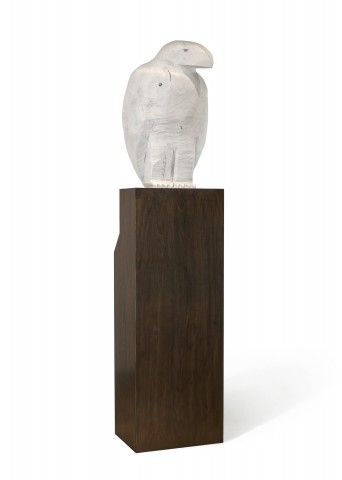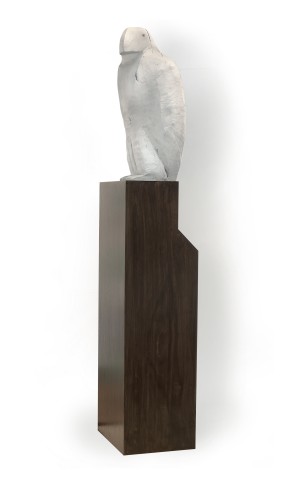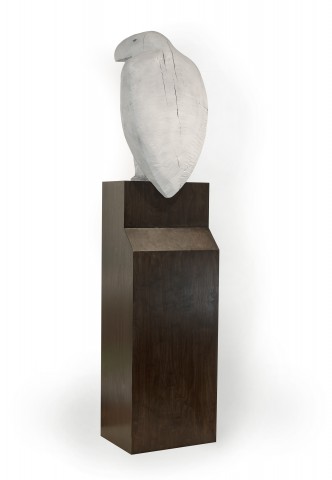BUNJIL, 2003
BRUCE ARMSTRONG
painted bronze
95.cm (height)
234.5 cm (height, including timber base)
stamped at base with Perin Sculpture foundry mark
Private collection, Melbourne
Bunjil, 2002, painted aluminium and wood, 2500 cm height, unique, commissioned by the Melbourne Docklands Authority, Melbourne
Eagle, 2002, painted wood, 500 cm height, unique, in the collection of the Pt. Leo Estate, Victoria
Towering high, perched on a smooth-edged timber plinth, Bruce Armstrong’s gleaming white bronze eagle, Bunjil, 2003 surveys his domain. Best known for having created monumental heraldic animals built to exist in open public spaces, from 2003 – 2012 Armstrong also created in parallel a small suite of editioned bronzes based on selected timber sculptures. From a small edition of 9, each with its own unique timber plinth, this eagle was amongst the first to be cast and coloured by Bill Perrin, whose technical prowess simulated almost exactly the materiality, appearance and texture of the artist’s original timber maquette.1 Originally conceived around 1996 as a painted timber totem roughly hewn from cypress wood, the simplified polychrome design of a sea eagle at rest was later scaled-up into a vast seven-story aluminium public sculpture, Eagle (also known as Bunjil), commissioned by the Melbourne Docklands Authority in 2002.2 Later joined by the pair of aquiline Guardians, 2009 installed at the entrance of the Hyatt Hotel, Armstrong’s avian sculptures have changed the aesthetic fabric of the city of Melbourne and provided its urban environment with a deeper, more spiritual connection to the land.
Bruce Armstrong, a self-confessed twitcher, writes: ‘Bird’s are everyone’s allegory, a totem for all personalities. Every culture has bird stories… one can sift through the history of art and find images of birds in the earliest of humanity’s imagery.’3 His oeuvre is peppered with avian forms, most devoid of naturalistic detail and adopting symbolic shapes of varying simplification. Some resting, others using their outspread wings as protective, encircling shields.
Painted a uniform white with pigments mixed with marine acrylic (a defensive weather patina), this bronze Bunjil stands proud with a striking silhouette, his eyes narrowed and beak slightly lowered, a watchful sentinel. Armstrong’s simplified colours and volumes serve to highlight the tactile surface texture of the bronze, the grooves and rough traces of his carpentry tools having been preserved throughout the casting process. This carved muscularity creates a raw commanding presence for Armstrong’s broad-shouldered bird of prey, evoking the ancient power of the wedge-tailed eagle creator spirit and ancestral being of the local Kulin Nations of South-Eastern Australia.
For the Wurundjeri-Woi Wurrung people of the lands around the Birrarung (Yarra River) and even further south to the Boon-Wurrung lands around Port Phillip Bay, Bunjil is revered as one of two moiety ancestors, the other being Waang, the crow. In these language groups, orally transmitted stories singing Country and Law featured Bunjil. They explained the creation of the local lands and provided guidance for moral and social behaviour. In these creation myths, the wedge-tailed eagle plays a very active role. Using his massive wingspan and from his beak, he blew winds of change and fashioned living things with his talons.
In spite of this energetic, world-building activity, Armstrong’s Bunjil is solidly static, its heavy mass finally at rest, balancing evenly on stylised columnar legs and roughly incised talons. With an endearing and habitual untidiness, Armstrong’s sculptures are raw and vernacular, their simplicity providing a blank and accessible canvas for interpretation and engagement with each viewer and environment.
1. Gott, T., ‘Acts of Love: The Art of Bruce Armstrong’, Bruce Armstrong. An Anthology of Strange Creatures, National Gallery of Victoria, Melbourne, 2018, p. 36
2. ibid., p. 35
3. Armstrong, B., ‘Why Birds?’ in Webb, V., MCA Unpacked II: Six Artists Select from the MCA Collection, Museum of Contemporary Art, Sydney, 2003, p. 8
LUCIE REEVES-SMITH


